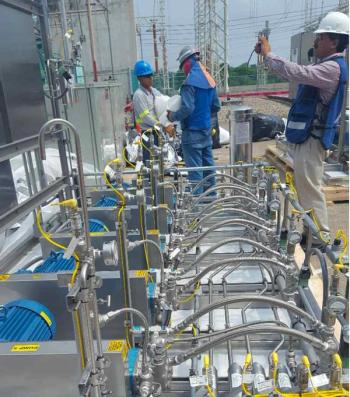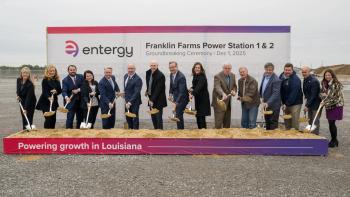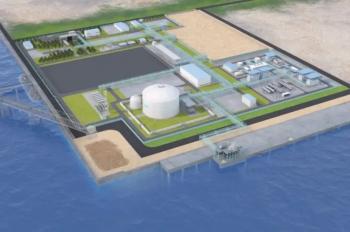
The future LNG plant: Electric or aeroderivative
Future LNG plants would be "all aero-derivative" driven or "all electric" driven. Practical notes and latest developments on LNG refrigeration compressor train design, driver selection and optimization are discussed. Useful notes and new technologies on "all electric" solution and associated power plant are also described.
In order to provide LNG refrigeration drive power, this has traditionally required the use of a tandem drive of heavy frame industrial type gas turbine and electric motor. The electric motor is termed a “starter helper motor” (SHM) as it provides the means of starting the heavy frame (most probably single shaft) gas turbine and the compressor. Once up to full speed, the SHM supplies active torque to increase the gas turbine output power especially at elevated ambient temperatures. When the ambient temperature is cold, the SHM can also act as a generator to export the excess of power.
Significant motor torque is required during startup (at lower speed) since the compressor starts loaded with positive pressure inside (to avoid wasteful and emission-intensive de-pressurization). An electrical variable speed drive is used to provide this feature. A load-commutated inverter (LCI) drive with brushless synchronous motor is normally selected for this duty as it satisfies the high torque starting duty with adequate reliability.
Alternatively VSI technology with induction motor may be used. Starter/helper motor (SHM) drives are usually with less than 50 MW power each at 3000 or 3600 rpm, depending on the gas turbine model/power/speed. These SHM drives should be incorporated into the plant electrical scheme. SHM is usually featuring a double-ended shaft inverter-fed electric motor installed between the gas turbine and the compressor. Side effects when using LCI drives such as harmonic interactions should be studied and mitigated by suitable methods. There has been an interest in electric drive motors for LNG modules (eliminating gas turbines) with obvious advantages of safety, efficiency, and availability, but the draw back is high capital expenditure for total plant including power generation unit. VSD electric motor itself is usually cheaper than gas turbine with same rating.
"All electric" concept presents new challenges. Maintaining an early exchange of information between operator, contractors and vendors of various parts of "all electric" LNG plant, including vendor of motor driven compressor, contractor of the power plant, vendor of electric transmission and distribution systems, etc can reduce cost and risk by critically reviewing various available designs and options.
Drive train optimization
Provision of low temperature to the LNG processes requires refrigeration cycles to remove huge amounts of heat from gas streams to liquefy them. Refrigerant compressor requires considerable amounts of mechanical power to increase the pressure and condensing temperature of the refrigerant vapors. This mechanical energy is provided by gas turbines or electric motors, which act as compressor drivers. There is a strong incentive in designing highly efficient, yet cost-effective LNG refrigeration compressor trains. Proper optimization methodology should be applied to a LNG plant in which optimal and near-optimal systems at various economic scenarios are identified. Also a systematic methodology for the integrated design of refrigeration and power systems should be addressed to improve the overall design of LNG plant.
Restricting the problem only to minimize the power consumption may in principle aim towards minimum total life costs, since large portion of total life cost is actually fuel/energy cost. However, this optimality may well be lost in a later stage if the resulting LNG plant leads to a poor driver or power plant selection under the given economic scenario. Simply considering minimum power consumption may result in too high initial cost or very complex LNG/power plant systems. Practical considerations such as the existence of gas turbines only as discrete options are often overlooked. Dissimilar type of gas turbine drivers is not usually acceptable since it would imply different maintenance regimes and more spare parts to be kept in the warehouse, which is also a capital investment (sometimes neglected in optimization or project initial studies). This concept could be extended to "all electric" LNG units. In other words, identical large electric motors are encouraged to maximum extent possible/practical. Synthesis of LNG refrigeration compressor trains, whether gas turbine driven trains or "all electric" system, has a very difficult mathematical nature. Generally power plant should be included in model for both options.
The refrigeration compressor train model is a highly nonlinear one (mainly due to physical properties, etc). On the other hand, in the synthesis of gas turbine driver or power systems, the majority of the many variables subject to optimization are binary, due to discrete equipment choices (particularly gas turbine selection). Although the formulation for gas turbine/power system design is in principle mixed integer nonlinear, a mixed-integer linear formulation may be derived and used. But best recommendation is to use original mixed-integer nonlinear formula. When these formulations (refrigeration and gas turbine/power systems) are merged in a single optimization problem, the resulting formulation would be unavoidably highly nonlinear and with many variables, most of them binary. Proper optimization procedure should be used.
Simplified or improper methods would seriously compromise the robustness of the solver and the quality of the solution. Nonlinear formulations are likely to get trapped in local optima in these circumstances and, therefore, a stochastic optimizer has been proposed. The manipulation of key degrees of freedom will ultimately facilitate a feasible match between a set of mechanical and electricity demands and a particularly attractive set of drivers and power plant. At this moment, it is also useful to introduce a new optimization variable such as plant capacity. Allowing the plant capacity to vary, at least within a restricted space, would permit the master optimizer to ensure a full utilization of the equipment capacity for a given machinery selection. It is very important since gas turbines are offered in discrete options usually with very different commercial/technical characteristics.
The savings resulting from a better match between energy demand and supply are usually considerable. There have been some purely theoretical optimization methods and results presented previously for various LNG designs in literatures and articles. Practical considerations such as avoiding dissimilar type of gas turbine (identical gas turbines), proper references for selected machinery, some serious constrains in initial budgets, etc are usually neglected. Best recommendation is to properly weight each theoretical and practical factor for optimization. Even items such as preferred gas turbine models, machine references in LNG services, etc could be properly weighted and involved in a realistic optimization.
Refrigeration compressors
background:white">Modern LNG refrigeration compressors are equipped with three-dimensional impellers machined from a solid forging (using five axis milling machine). This manufacturing process can offer excellent control of the blade geometry without reducing tensile properties associated with weld joints. This technology also increase steel alloy options without constrains of material weld-ability. The single-piece impeller fabrication method guarantees repeatability and improves performance. Large LNG compressors should be designed to optimize both rotor-dynamics and aerodynamic performance. Seal design/selection and seal support systems for LNG compressors are very important. The ability to supply buffer gas during compressor settle-out condition is critical.
A common design is an on-board booster compressor, eliminating the need for external buffer gas (or other external solutions) that can contaminate the compressor loop and seal. Functional testing of complete systems of dry-gas-seal during all operating and emergency conditions should be included in compressor performance test. Sometimes after compressor performance testing, in order to meet the very stringent operating tolerances, it may be necessary to tune the compressor performances by trimming some impellers.
The future power plant for LNG
background:white">Availability and reliability of electric motor in "all electric" solution as well as SHM applications are only as good as the reliability of their power supply system (power plant). Apart from the obvious harmonic interactions with the plant variable speed drive systems (both harmonic voltage distortion in the supply system and harmonic torques in the motor-compressor string) there are subtle effects that can be problematic if not addressed properly. Low frequency influences could affect power plant stability. Possible sub-synchronous resonances leading to mechanical failure have also been observed. Accurate harmonic and inter-harmonic studies require power generation plant details including generation train inertia, automatic voltage regulator (AVR) and turbine-governor response data. The stability of the electrical power system in a LNG plant should be proven even under disrupted process conditions. Operators should be satisfied with dynamic simulations demonstrating the continuity of the liquefaction process under certain disruptive conditions, one of most severe cases having been identified as the unexpected loss of a turbo-generator-set in the power plant.
By adopting effective control strategies, the remaining healthy generation-sets can be made to assume the load of all refrigeration compressor drivers while keeping the compressors within their stable operating envelop (keeping the liquefaction process going). Special Energy Network Monitoring and Control (ENMC) systems assist in coordinating the individual automation subsystems of an "all electric" LNG refrigeration plant and in re-establishing the power balance after a major source or load of the electrical system is disturbed. Dynamic simulations can predict such scenarios and suggest design modifications or mitigation measures to avoid uncertainties and possible risks stemming from these phenomena. Provision of reliability is paramount to a LNG plant. The ability of a power plant to recover from sudden generator outage conditions is a significant element in these studies.
Since "all electric" LNG plants usually include a power plant with steam system in the combined cycle arrangement, the response of the water-steam cycle elements is also critical. If process steam is additionally extracted from the power plant, or steam generated and exported to power plant, the continuous supply of steam should also be included in the simulation. Vendor should provide actual response time constants based on accurate database simulations rather than the typical values from previous projects. RAM (reliability, availability and maintainability) studies can be performed by independent consultants to verify the key assumptions made by operating companies and vendors.
Unlike fixed-speed motors, the operation of a VSD controlled motor usually shows a soft, smooth and fully controlled starting behavior without noticeable surges. Generally the installation of large VSD on a plant does not raise major concerns in the power plant design. One of the issues that can cause problem is the inrush current due to the magnetisation of the VSD transformer. When this problem is foreseen, the usual pre-magnetization system through the secondary of the transformer could be implemented as well as a dedicated requirement concerning the induction value of the equipment. Another issue that can cause problem is related to the load-step. In case of a shutdown of the VSD system, the disturbance (loss of a major consumer that could represent more than 20% of the load balance) can cause instability of the power supply system. In plants where the VSD system load is a significant percentage of the overall power demand to the installed power plant capacity, the power plant supplier should verify that it could operate at all known operating and upset conditions. This is particularly relevant for the pressurization sequence of the compressors, where the MW/second ramp-up requirement should be matched by the plant step-up capabilities. In addition, logic is required to define the load shedding philosophy in order to prevent a plant wide shutdown in case of loosing a major load or a generator. Load shedding logic is even more important for a plant with VSD than a plant without any VSD.
Another main issue is related to inter-harmonic effects on the turbine-generator trains. VSD systems, depending on their technology, can continuously produce small torque oscillations (for example based on the difference between the network frequency and the motor frequency) on the turbine-generator shaft line. The effects of such torque pulsations should be analyzed carefully, along with other torsional excitations from the turbine-generator to prevent any mechanical resonance to reach beyond the permissible values. The high power density of the advanced technology combined cycle power plants enables a compact and high performance plant arrangement. Integrated gas turbine and steam turbine systems are capable of achieving above 60% efficiency. Their environmental impact per kilowatt-hour of produced energy is the lowest of all driver options.
The use of more flexible, high performance and fast starting aero-derivative gas turbine for power generation offers great flexibility. Particularly it makes the impact of an unscheduled issue (such as a trip of a gas turbine-generator set) less important. Power generation plants based on aero-derivative gas turbines offer highest possible efficiency and importantly, more flexible operation, startup and shutdown. Fast-acting aero- derivative gas turbines can considerably improve power plant abilities to ramp-up.
Amin Almasi
Mechanical Department, WorleyParsons Services Pty Ltd, 60 Albert Street, Brisbane, QLD, 4000, AUSTRALIA
Email:
Newsletter
Power your knowledge with the latest in turbine technology, engineering advances, and energy solutions—subscribe to Turbomachinery International today.





